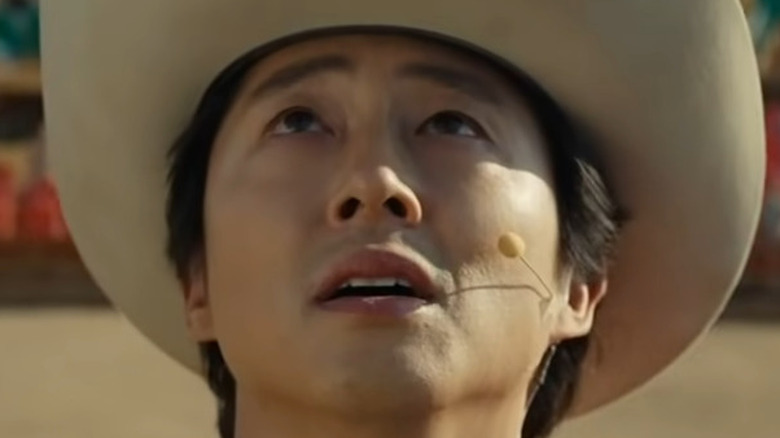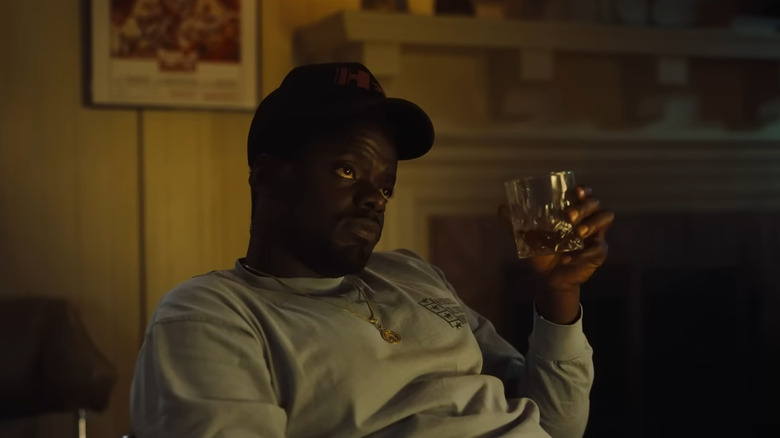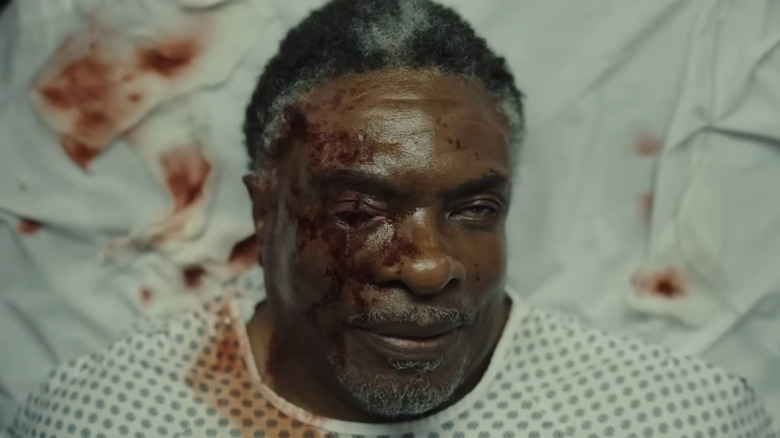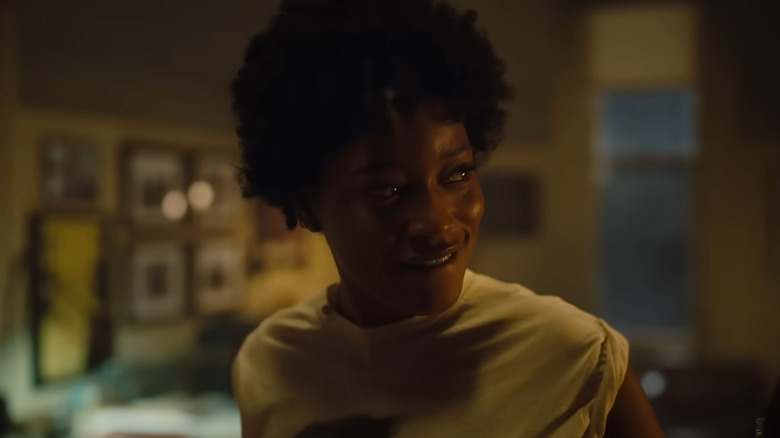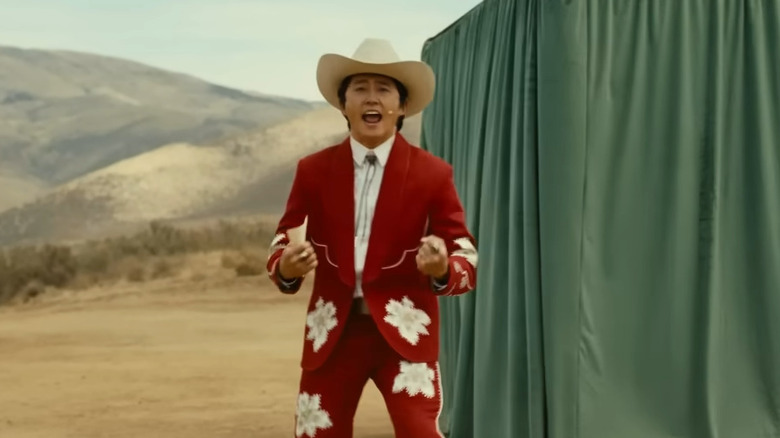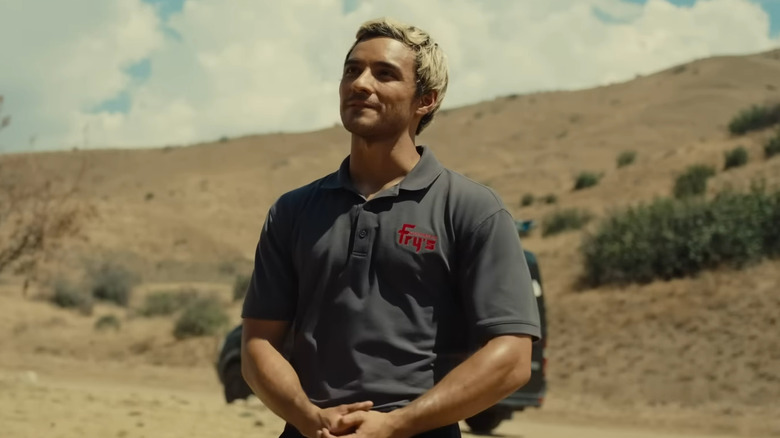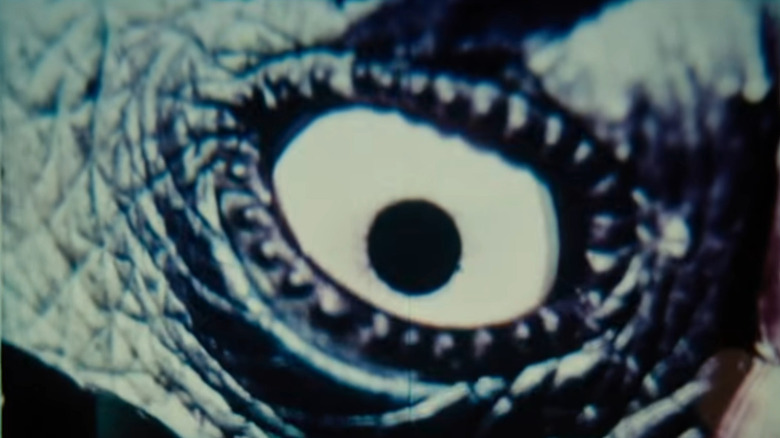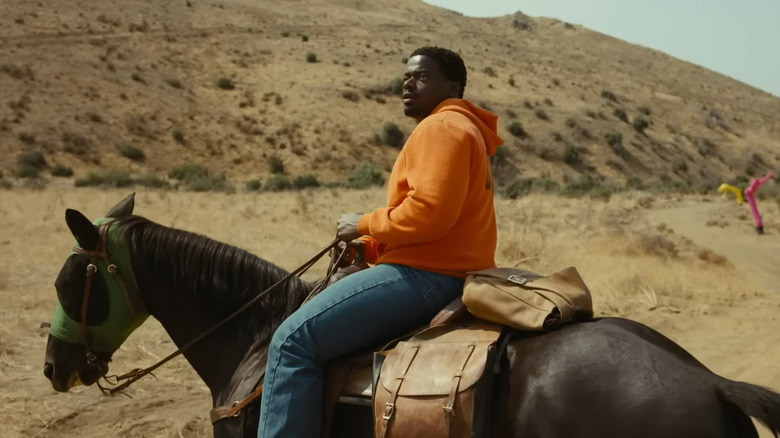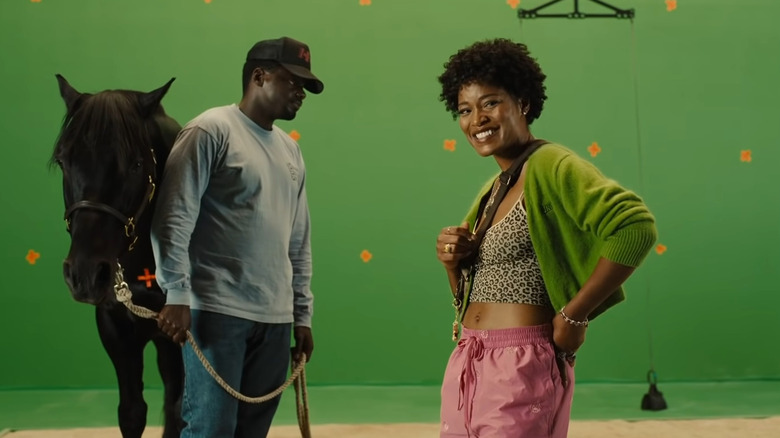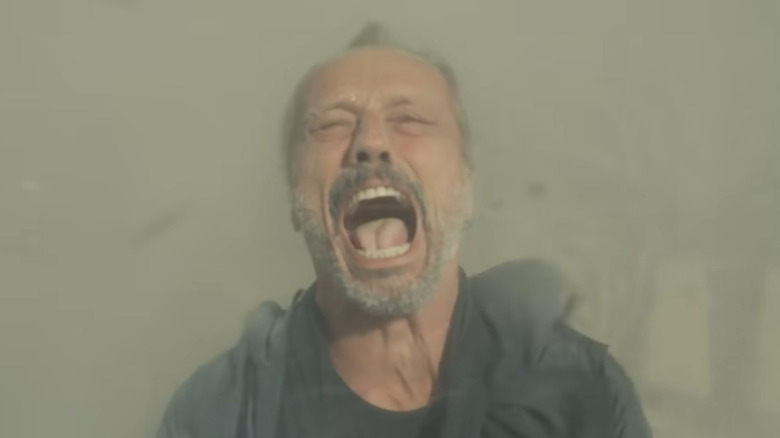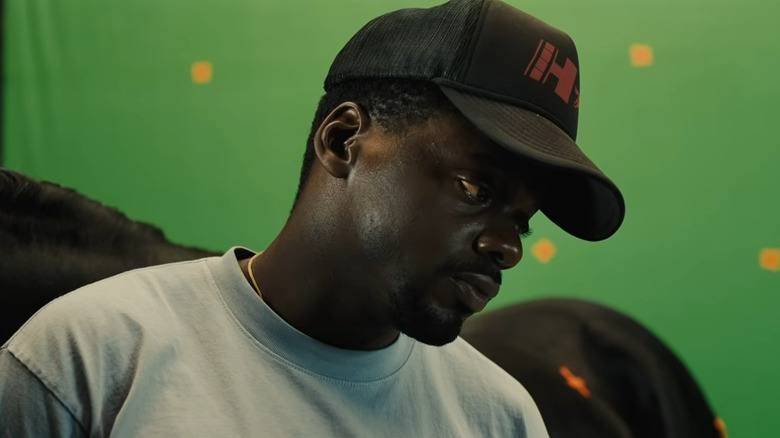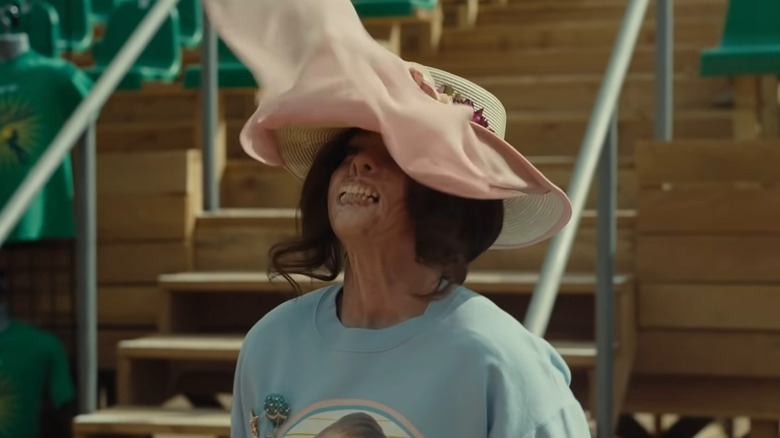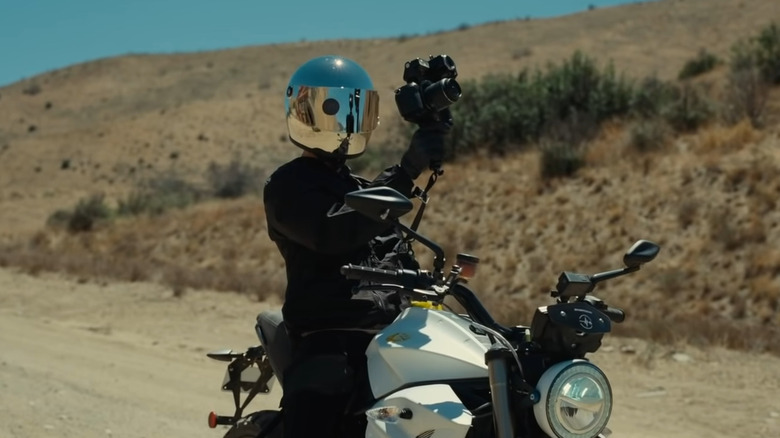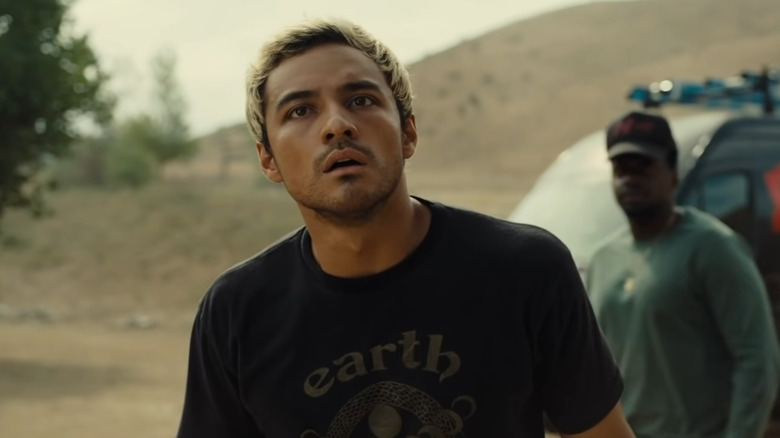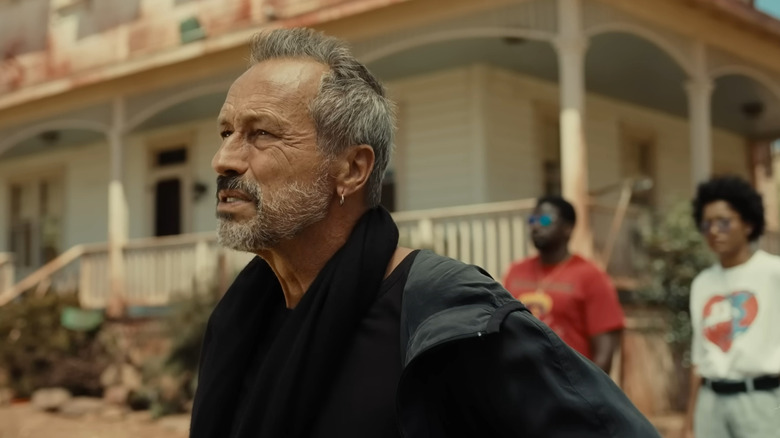Small Details You Missed In Nope
Jordan Peele's "Nope" is a blend of many things — classic Hollywood westerns and science fiction stories, contemporary horror, meta-commentary on the nature of filmmaking, and parody, just to name a few. It's a dense and sprawling movie that consistently builds in both complexity and momentum, culminating in an epic climax of cosmic proportions.
In a film with so many twists, turns, and revelations, every shot is important. Peele is a master of setting the stage for what's to come, and "Nope" is packed to bursting with little details that either flesh out the world or directly foreshadow future events. Watching the film is like deciphering a puzzle box, with each seemingly unrelated corner playing into the greater whole in unexpected ways. It's understandable, then, how some of the film's smaller touches can easily go unnoticed your first time through.
From homages to classic sci-fi movies to smaller bits of world-building, there are a lot of Easter eggs and hidden meanings sprinkled throughout the film. Here are some small details you may have missed in "Nope" and what they mean in the greater context of the film. Be warned, there will be major spoilers ahead.
A biblical beginning
"Nope" opens with a piece of scripture from the biblical book of Nahum — specifically, Nahum Chapter 3, Verse 6. In the Bible's New International translation, the verse reads as follows: "I will pelt you with filth, I will treat you with contempt and make you a spectacle." It's an epigraph of graphic proportions, and it certainly sets the stage for what's to come. However, there are a couple of different ways to interpret the meaning of this verse in the context of the film, and some of them require a greater understanding of its biblical context.
Nahum Chapter 6 primarily deals with God's judgment against the Assyrian city of Nineveh, which is portrayed as a deeply sinful and debaucherous place at various points in the Old Testament. As a result, one way to read Jordan Peele's use of the verse is as a commentary on Hollywood and its role in modern culture. "Nope" is a movie that deals heavily with the self-destructive nature of Hollywood, how it can change people for the worse, and how it often twists trauma and tragedy into profit. Ricky Park (Steven Yeun) uses his dark past as a source of income, and Holst (Michael Wincott) ultimately chooses to die because he's so obsessed with his craft.
Alternatively, the opening scripture could be read as a foreshadowing of the alien's attack (it acts as a kind of violent god in the story and certainly pelts the Haywoods with filth), or simply as a commentary on the horror genre at large.
Actors of importance
The whole cast of "Nope" does a stellar job, and while Daniel Kaluuya and Keke Palmer certainly lead the charge with two powerhouse performances, two of the film's other actors have some greater significance beyond simply playing their parts.
First and most importantly, sci-fi and horror legend Keith David is the perfect choice to play Otis Haywood. Though he doesn't appear in much of the movie, Otis' shadow stretches from beginning to end, like his ghost haunts every frame of the film. Given David's extensive history in the genre, that makes a lot of sense. The actor famously collaborated with sci-fi horror director John Carpenter on both "The Thing" — a movie about an animal-esque alien hiding among humans — and "They Live" — a movie about a man discovering that there are aliens all around him. Simply by including David in such a pivotal role in "Nope," Peele both pays homage to the actor's contributions to the genre and invokes several classic films from which he clearly took inspiration.
Less symbolic, but still interesting, is that prolific performance capture actor and stuntman Terry Notary plays the terrifying chimpanzee Gordy in the film. It's far from Notary's first time playing an ape, as he previously portrayed Rocket in the "Planet of the Apes" reboot trilogy and King Kong himself in "Kong: Skull Island."
All the alien connections
"Nope" features a lot of references to aliens from the beginning, even before the flying creature makes itself known to OJ and Emerald. Jupiter's Claim, the Wild West theme park run by Ricky Park, evokes a galactic energy with its name alone. The film deals heavily with the territorialism of animals, with the monstrous alien ultimately revealed to have staked a claim to the Haywood ranch. The name of Jupiter's Claim foreshadows that extraterrestrial territorialism before the creature ever appears on screen.
Additionally, the sign that marks the way out of the back of the park reads "Out Yonder," which could be interpreted as a reference to space as well as a general cowboy phrase. Whether intentionally or not, it evokes the 1960s sci-fi anthology series "The Outer Limits," which, as a fan (and later producer) of "The Twilight Zone," Jordan Peele is certainly familiar with.
Other alien details include the crashed flying saucer sign in front of Fry's Electronics, and the fact that OJ drives a Polaris UTV around the ranch in multiple scenes. While Polaris is a major real-world company that does indeed make those kinds of vehicles, the company's name is also a reference to the North Star, which seems a bit too perfect to be a coincidence.
Gordy's Home foreshadows the rest of the movie
The first proper scene in "Nope" is a glimpse at the gruesome "Gordy's Home" disaster, which is shown in more detail later on. While the full scope of what happens isn't clear at first, the "Gordy's Home" scene features a bunch of little details that foreshadow the rest of the film.
For starters, the actual chain of events at the "Gordy's Home" taping parallels the alien encounter later in the film pretty directly. In both cases, a potentially dangerous creature is used to turn a profit by performing in front of a live audience. And in both cases, eventually, that creature becomes fed up and, as Ricky himself says in the film, "hits his limit." The irony is only strengthened by the fact that Ricky himself orchestrates the second catastrophe with the alien, as he experienced the horrors of Gordy's rampage firsthand.
There are a few other details in the "Gordy's Home" scene that tie into the rest of "Nope" as well. For example, the father character on the sitcom is referred to as "a man who can send a rocket into space," tying him into the film's greater extraterrestrial theme. Additionally, it's the release of balloons that ultimately seems to set the chimp off, mirroring how Emerald eventually destroys the alien by releasing a giant balloon into its maw.
Angel is mining crypto
One of the more curious characters in "Nope" is Brandon Perea's Angel Torres, an ordinary tech store employee whose affinity for alien conspiracy theories brings him into the thick of OJ and Emerald's investigation. Angel comes off as a relatively frazzled person at times, but he's also clearly capable of getting the job done when push comes to shove. Perhaps that's because he has the benefit of a passive stream of income — or more specifically, a miniature crypto mining operation set up in his bedroom.
After they escape from the alien creature and the Haywood Ranch, Angel brings OJ and Emerald back to his place for a debrief. In the background, you can see that he has a rack of what appear to be processors rigged up to his computer, with multiple fans blowing on them to keep them cool. Given Angel's tech-savvy nature, it makes sense that he'd try to make a little extra money via his own personal crypto mine.
In another scene, Angel is shown using a Razer laptop — a popular brand that focuses on gaming gear. Clearly, he takes his computer business seriously, though it might have been more appropriate for him to have some Alienware hardware around.
All the eye imagery
Throughout "Nope," there are numerous lines and visual touches referring to the eyes. OJ quickly learns that the alien is less aggressive if you don't look up at it — a trick that he learns from working with the horses. And yet, at the same time, there's an obsession with seeing things in "Nope."
OJ, Emerald, and the rest of the crew repeatedly return to the ranch because they need to get the perfect shot of the alien. Things only become more intense after Holst, the famous director from the beginning of the movie, is convinced to join their cause. Holst is obsessed with landing the "impossible shot" of the alien, to the point that he seems to nearly lose all sense after doing so. In the scene where Emerald first reaches out to him about their mission, Holst is seen editing black and white footage of animals, with many of the shots simply being close-ups of the creatures' eyes. He then makes a reference to being famous — having all of the eyes of the world on you — being like a dream that you never wake up from.
Clearly, there's some meta-commentary going on here, with Peele discussing both the optics of fame and the "eye" of the film director that he himself is. And of course, Em finally gets the perfect picture of the alien via the well camera at Jupiter's claim, which itself could be perceived as a massive, gaping eye.
The chapter titles foreshadow who dies
"Nope" employs the use of chapter titles to break up the flow of events: "Ghost," "Clover," "Gordy," "Lucky," and "Jean Jacket." While these might seem incidental at first, especially as the first two simply refer to the names of horses at the Haywood ranch, they hold a special significance.
Each chapter is named after a creature — three horses, one chimpanzee, and one massive alien monster. And in each case, the creature named dies in their respective chapter, with one notable exception. Ghost is the first horse taken by the alien, with Clover following soon afterward. The Gordy chapter is a bit different, as it's just a brief flashback, but it also features the death of the eponymous ape. The only creature to escape the fate foretold by the chapter titles is Lucky, which turns out to be an appropriate name. Despite everyone else at the Star Lasso Experience being devoured by the alien, Lucky remains unharmed, even surviving through to the end of the film.
If you happened to recognize this pattern, then you'd have had reason to suspect that the alien would die in the chapter entitled "Jean Jacket." Though it's the name of a horse, it's also the name OJ gives to the monster, and it ultimately falls at Emerald's hands.
Emerald messes up her speech because of her dad
Emerald is first introduced on the set of one of Antlers Holst's commercial shoots, where she and her brother are hired as animal wranglers. They don't hold that position for long, as stupid behavior from the other folks on set results in the horse, Lucky, acting out, but they do hang out long enough for Emerald to deliver an extended sales pitch for herself and the Haywood ranch. Where OJ clearly lacks any love for performance or public speaking, Emerald is a natural, and she quickly rattles off the entire Haywood Hollywood history — a history that she claims goes all the way back to the first motion picture ever.
Despite Emerald's expert delivery, however, she does stumble at one point, referring to her esteemed ancestor as her great-great-grandfather, rather than as her great-great-great-grandfather — a slip that OJ immediately catches and corrects her on. Later on, we see why Emerald gets the number of "greats" wrong.
Toward the end of the film, Emerald is seen watching an old VHS tape featuring the recurring man-on-a-horse movie. In the background, her father can be heard delivering the exact same speech word for word that she delivers earlier in the film. The reason Emerald makes the mistake is that she learned the speech by memorizing this particular recitation from her father. And because her father is one generation older, he only says two "greats" where Emerald should say three.
The nature of the alien is revealed early on
In keeping with the old-school Hollywood films that inspired it, "Nope" has an extended opening credits scene that might be a bit confusing your first time through. The credits are displayed in what looks like a cave covered in billowing sheets, with the "mouth" eventually giving way to the original "movie" of a man riding a horse. In reality, the opening credits do take place within a mouth, but not in the mouth of a cave — rather, the mouth of the alien creature who terrorizes the Haywood ranch.
Because the alien is believed to be a spaceship for much of the film, this is an easy detail to miss. And yet, when the staff and guests of the Star Lasso Experience are sucked up into the monster's maw, it's shown to be the exact same as the venue of the opening credits. OJ makes another allusion to the UFO's true nature following an early encounter with it, in which he tells his sister that he has to get back to work because he's got "mouths to feed." If you know what to look for, these clues foretell the true nature of the alien before it's officially revealed, though it would be hard to guess what you're seeing in the opening credits your first time through "Nope."
Animal wranglers are the real heroes
The two main characters of "Nope" grew up on their father's ranch and were taught the trade of animal wrangling — a skill that probably doesn't get enough love or respect in pop culture. Perhaps that's why Jordan Peele spends so much time in the movie emphasizing the importance of the job.
Yes, OJ, Otis, and Emerald all work in the field of animal wrangling, but the film's endorsement of that work goes far beyond its protagonists simply being a part of it. For instance, the "Gordy's Home" tragedy might never have happened if the animal wranglers on set had been better prepared or more focused on safety. OJ's knowledge of animals also ends up being the key to defeating the alien, as he realizes the trick of keeping one's eyes averted by reflecting on his time with the horses.
By contrast, Ricky and Holst only seem to view animals as subjects of spectacle, with Ricky trying to use the alien's presence to turn a profit and Holst fixating more on his shots than on the animals themselves. In a way, you could say that "Nope" is one long cautionary tale about the importance of treating all creatures with respect.
Ricky's trauma is visible everywhere
Ricky Park has a rough time of it in "Nope." Though he seems to be a pretty successful business man, he's clearly haunted by the trauma of his experience on the set of "Gordy's Home." His secret room of memorabilia from the show — in which he claims a couple once paid him $50,000 to stay overnight — is plenty creepy, and it features a few details that make it even creepier. For instance, the bloodied shoe from his presumably dead former castmate is displayed in an upright position, just as looked to him from his hiding place during Gordy's rampage. Even when Ricky's talks about the incident to OJ and Emerald, he's clearly repressing a lot. He raves about a "Saturday Night Live" sketch parodying the incident, describing Chris Kattan as a "force of nature" (a curious choice of words).
Later, when the Star Lasso Experience is revealed, there are even more remnants of Ricky's horrifying experience. The alien costumes that he has his children wear for the act (also sold in doll form) look strikingly similar to chimpanzees, which is an interesting choice given Ricky's history with the animals. And of course, there's the fact that he invites his scarred former "Gordy's Home" co-star to his alien sideshow, only for her to be swallowed up by the creature along with him.
The Akira slide
Few shots in modern cinema are as iconic or as frequently referenced as the famous motorcycle slide shot from "Akira," the 1988 cyberpunk anime masterpiece. The shot has been parodied and outright mimicked numerous times over the decades since the film was first released, and it shows up once again during the climax of "Nope."
While racing away from the alien on the paparazzi journalist's bike, Emerald performs the iconic slide, racing outright from the camera and skidding to a stop. In addition to being a reference to "Akira," the shot is also the payoff to a line from the beginning of the film. When Emerald is giving her speech to the crew of Holst's film early on, she closes by pitching herself, mentioning that she does all manner of creative work around Hollywood and is always available. One of the random skills she mentions is that she rides motorcycles, which obviously comes in clutch during the final act.
The alien's true form
As the end of "Nope" approaches, the alien transforms from its traditional UFO shape into a much more abstract and bizarre creature. The "saucer" that it once was expands and billows into a massive, flowing entity somewhere between a giant squid and a fitted sheet. The creature also reveals a ... mouth? Eye? Or something else entirely, which takes the form of a small square in the center of the alien's body. All in all, it's a baffling design, effectively conveying the otherworldly status of the beast.
There are a few things worth noting in the alien's final form. For starters, its body takes on much the same consistency as the wavy tube men seen throughout the movie — referred to as "sky dancers" at one point in the film. While that is a common name for the joyful decorations usually seen at used car dealerships, it seems like it probably has a double meaning in "Nope." The purpose of comparing the alien with the sky dancers is amorphous, but it certainly adds an eerie quality to the whole finale.
Also of special interest is the square organ that comes out of the creature as it assumes its final form. The way it repeatedly pulses out new waves of its ribbon-like maw evokes the mouth-within-a-mouth of the xenomorph from "Alien," though it's unclear if that's by design. The constant flashing of the organ also feels evocative of the old-fashioned cameras used in the film, as if the alien is filming the humans as they're filming it.
It's all connected
From start to finish, "Nope" is littered with throwaway lines and visual touches that tie all the little things into the greater narrative. OJ mentions early on that the first film he ever worked on with his father was "The Scorpion King," and that they brought a horse called Jean Jacket for the shoot. Later on, OJ names the alien Jean Jacket and wears his Scorpion King crew hoodie into battle against it. In a way, he sort of even becomes the rider in the old horse movie who he claims as an ancestor, racing onto Holst's crank-powered camera just as the black-and-white film races through the opening credits.
No detail is left to chance. Angel wears a t-shirt that reads "Earth" over a graphic of a dragon and different phases of the moon. Emerald wears several different pieces of clothing evoking pop culture references, including a shirt with Tex Avery's Slick Joe McWolf. Even Holst's awkwardly hilarious recitation of Sheb Wooley's "The Purple People Eater" seems to hold a deeper meaning. "I saw him last night on a TV show," Wooley sings in a verse unheard in the film. "He was blowing it out, a-really knockin' em dead."
Could this unsung lyric be a reference to the horrific "Gordy's Home" scene? Maybe. Or maybe not every detail in a Jordan Peele movie needs to be dissected so extensively. But when a director packs so much into every scene, it's hard not to look for all the little details that might be hiding there.
